York, East Riding of Yorkshire
Up to 1834
As early as 1551, part of St Anthony's Hall, an early local prison establishment, was being deployed for use as a poorhouse. In 1567 and 1569, two weaving establishments were set up for the unemployed in the city in St Anthony's Hall and St George's House, but the goods they produced were unsaleable (Kerridge, 1985). Ten years later, the city spent £400 on wool for the poor to work on. In 1597, a man from Hartlepool was given a generous contract to set up a fustian manufactory employing the poor, but the scheme failed. A similar arrangement, equally unsuccessful, was made in 1619 with Edmund Whalley, a worsted weaver from Norwich. At around the same time, an attempt was made to introduce the making of Kendal cloth in the hospital or workhouse. In 1655, St George's House (its name now corrupted into "The Jersey House) was converted into a workhouse for the use of two woollen weavers who had been brought into the city to provide work for the poor in the form of spinning and carding. For this task they were given the freedom of the city, £50 in cash, an interest-free loan of £100, use of the Jersey House and its grounds at a nominal rent, and a year's supply of spinning-wheels and cards. Again, the scheme proved ineffective. A similar project in 1698 involving a serge-maker from Masham also foundered.
In 1729, proposals were made for a residential workhouse to be set up in York but did not progress due to local opposition. Another effort was made in 1737 but was again delayed although the city corporation did set up a workhouse-manufactory to raise money and provide work for the relief of the city's poor. The parishes eventually went their own way with St Martin le Belfrey, St Martin cum Gregory, and St Martin, Coney Street, setting up workhouses in 1744, and St Mary Castlegate doing so the following year. Finally, in 1768, a number of the city's parishes set up a joint workhouse to accommodate 90 paupers in a former cotton factory at 26 Marygate, York (now the site of the Post Office Social Club). The inmates worked at textile production.
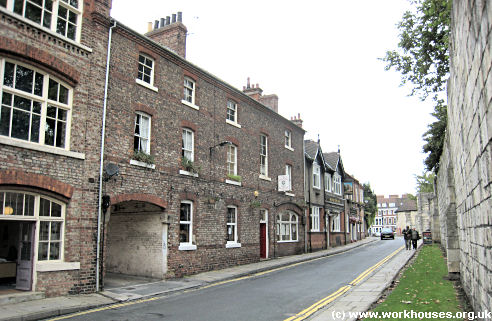
Site of the former Marygate workhouse.
© Peter Higginbotham.
The parish of Askham Richard operated it own local pauper accommodation. The 1849 map below indicates a row of small poor houses on Buttacre Lane at the south of the village.
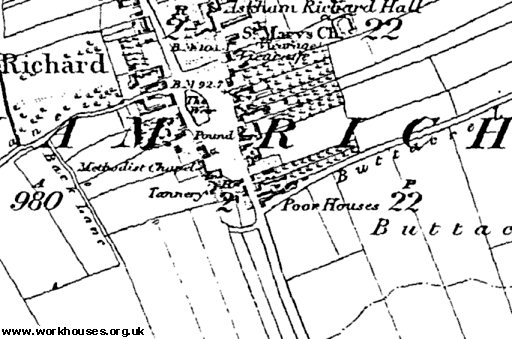
Askham Richard poorhouses site, 1849.
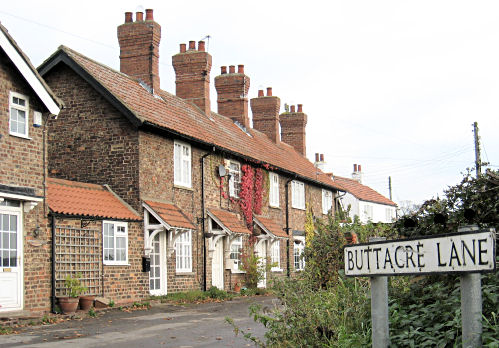
Askham Richard poor houses site, 2010.
© Peter Higginbotham.
After 1834
York Poor Law Union was formed on 15th July 1837. Its operation was overseen by an elected Board of Guardians, one from each of its 79 constituent parishes as listed below:
City of York:
All Saints, Pavement; All saints, North Street; St John, Micklegate; St Giles in the Suburbs; Holy Trinity, Goodramgate; St Mary, Bishophill, Younger (part of); St Michael, Spurrier Gate; St Dennis; St Margaret's; St Maurice; Holy Trinity, Micklegate; St Mary, Bishophill, Senior (part of); St John, Delpike; St Martin; St Cuthbert's, St Helen on the Walls, and All Saints, Peasholm; Holy Trinity, King's Court; St Michael-le-Belfrey; St Martin-cum-Gregory; St Sampson; St Helen, Stonegate; St Andrew;, Minster Yard with Beddern; St Lawrence; St Saviour's; St Mary, Castle Gate; St Nicholas; St Crux; St Peter-le-Willows; St Peter the Little, Parish of St Wilfred; St Wilfred; The Liberty of Mint Yard.
Ainsty of the City of York:
Askham Richard; Acaster Malbis; Bishopthorpe; Copmanthorpe; Holgate; Dringhouses;
Middlethorpe; Gate Hemsley [Gate Helmsley]; Haxby; Osbaldwick; Murton; Strensall;
Warthid; Dunnington; St Paul's, Heslington.
County of the North Riding of York:
Butter Crambe; Claxton; Flaxton-upon-the-Moor; Harton; Sand Hutton; Heworth; Upper Helmsley; Holtby; Earswick; Huntington; Towthorpe; Clifton; St Olave, Mary Gate; Rockcliff, or Rawcliffe; Overton; Lillings Ambo; Stockton on the Forest; Wiggington; Benningborough.
County of the East Riding of York:
Grimston; Kexby; Stamford Bridge with Scoreby; Elvington; Deighton; Escrick; Fulford Gate; Fulford Water; St Lawrence, Heslington; Naburn; Stillingfleet with Moreby; Thornganby with West Cottingwith; Wheldrake; Langwith.
The population falling within the union at the 1831 census had been 39,645 — ranging from Langwith (population 44) to St Cuthbert's, St Helen on the Walls, and All Saints, Peasholm (1,805). The average annual poor-rate expenditure for the period 1834-6 had been £12,335 or 6s.4d. per head of the population.
Initially, the new York Union took over the existing workhouse on Marygate. It appears that conditions in the establishment were far from hygienic. In August 1839, a number of the inmates became violently ill after eating some soup. The Guardians sent off a sample for analysis by a local chemist, Mr W White of Monk Bar, York. The minutes of the Guardians' meeting on 29th August, included his report:
Despite White's concern regarding the mucus and putrefaction, the Guardians decided that the soup had made inmates ill because "...the usual quantity of Potatos [sic] had been omitted making the soup too strong and rich..."
By 1845, because of its overcrowded and insanitary conditions, the Poor Law Commissioners strongly recommended the construction of a replacement for the Marygate workhouse. One inspection reporting 'a permanent reservoir of foul air' and the privies were 'without exception in an offensive state' with an open cesspool in the girls' yard. Most of the inmates were 'children, the aged and infirm and persons of weak mind'; many, if not all, were diseased and children associated 'in the infectious wards with adults labouring under syphilis and gonorrhea'. The paupers were said often to tease the idiots 'as a pastime'.(Tillott, 1961).
August 16, 1845, the Leeds Mercury reported the results of an official inspection of the premises:
A report has been made by Mr. W.H.T. Hawley, assistant poor-law commissioner, which gives an account of the frightful state of things at the York Union Workhouse, as affecting the bodily health and mental condition of the pauper inmates. It presents a sad account of the women's ward: this place is used by aged idiots, women and children, and besides being of limited extent, it has only one privy, with an open cesspool. The aged women's day-room is also described as too small, and their bed-rooms (which are also occupied by female idiots) as damp. dark, and badly ventilated. The improper position and bad accommodation of the infirmary for the females, and the lying-in ward, are also the subjects of allusion in the report. In speaking of the former, the infection of two children, previously in a healthy state, is ascribed to the patients having to resort in common to the single privy in the women's yard. There is no water closet on the premises. The lying-in ward, besides being too small and badly ventilated, comes under the additional ground of condemnation, of being immediately under the bed-room of the boys, who are able to hear everything that passes there. The boys' yard, which is occupied by boys, aged men, idiots, foul patients, and old married couples, has all the defects of the other departments of the workhouse. It is stated to be in the worst possible state both in regard to light, air, cleanliness, and classification. This deplorable state of the workhouse is fully borne out by a communication from Mr. Richard Thomas, surgeon, who gives a truly shocking picture of the want of accommodation, and its dreadful effects upon the health of the inmates.
In September 1847, the Guardians agreed to build a new union workhouse at a site at the north of the city on Huntington Road. The old Marygate premises were subsequently taken over by the York Industrial Ragged School.
The design of the new workhouse was opened to competition with the winning entry coming from local architects JB and W Atkinson. The building, which was to house up to 300 inmates was completed in 1849 and cost just under £6,000. The workhouse layout is shown on the 1850 map below.
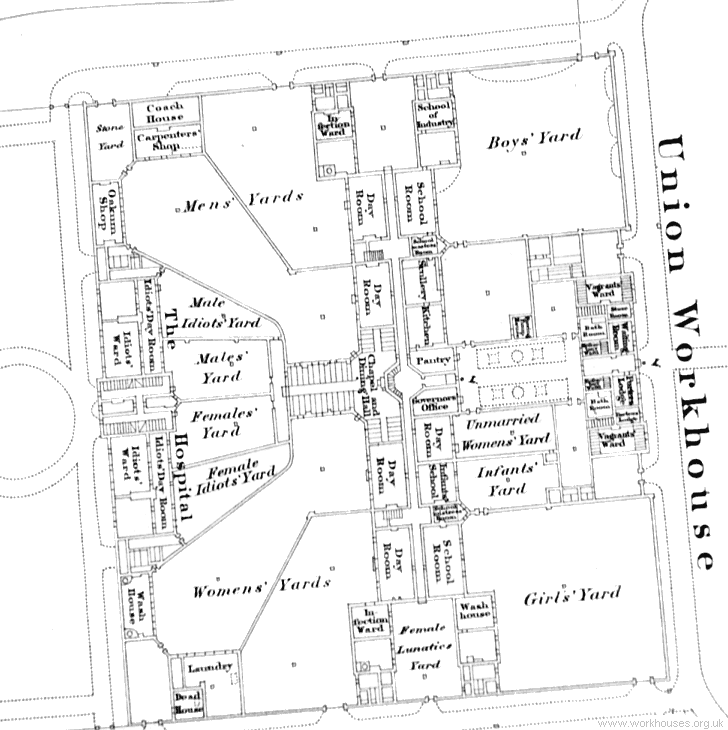
York workhouse site, 1850.
There were three main sections to the building: an entrance block at the east, a hospital block to the west, and the main block at the centre. The main block was said to deliberately resemble a mill. Males were accommodated at the north of the site and females at the south. Walls were used to create a complex arrangement of exercise yards for the different classes of inmate, including one specifically for unmarried women — perhaps a euphemism for unmarried mothers. The hospital contained wards and yards specifically for "idiots". Utility buildings on the women's side included the washhouse and laundry, and the workhouse mortuary. On the men's side were an oakum-picking shop, carpenter's shop, stone yard, and a coach-house. Although an area for female lunatics was placed on the women's side, no equivalent existed on the men's side.
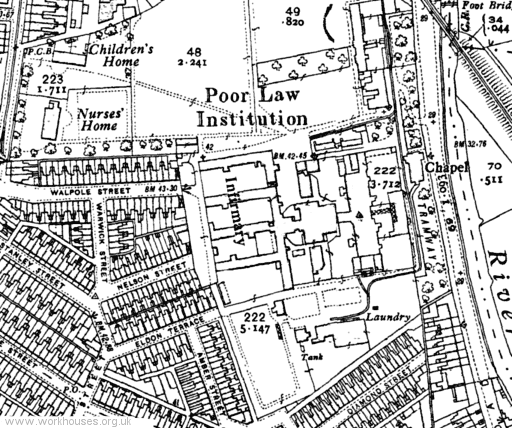
York workhouse site, 1930.
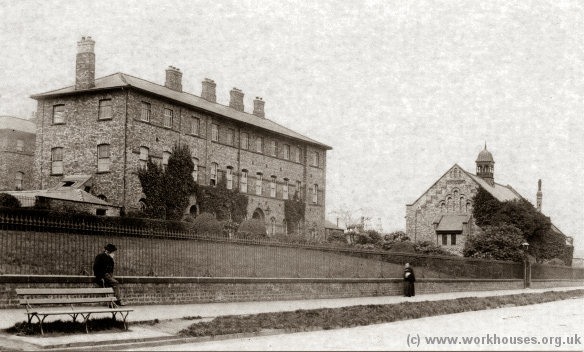
York workhouse entrance block and chapel from the south-east, c.1905.
© Peter Higginbotham.
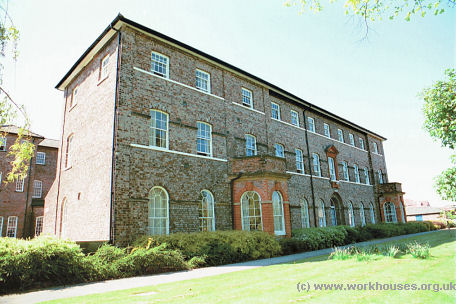
York entrance block from south-east, 2001.
© Peter Higginbotham.
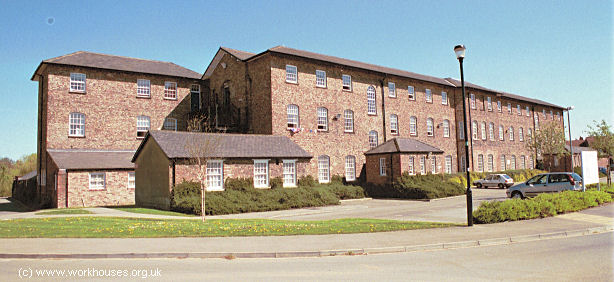
York main block from the north-west, 2001.
© Peter Higginbotham.
In 1852, John Wilson, the great-grandfather of former British Prime Minister Harold Wilson, became master of the workhouse, with his wife Esther as matron. The couple had previously held similar positions at the Helmsley workhouse.
In 1868-9, the workhouse was substantially extended with a large new infirmary, new boys' dormitories, and extensions to the kitchen, scullery, and boys' school-room and workroom. The new infirmary, at the west of the site, comprised four parallel ranges running east-west and linked at their eastern end. Female wards were at the southern end, those for children in the middle, and those for men at the north.
A chapel was added at the north-east of the workhouse in 1887.
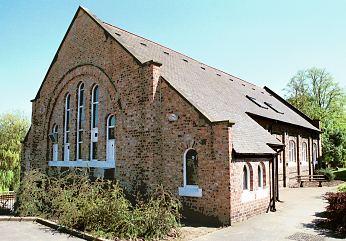
York chapel from the north, 2001.
© Peter Higginbotham.
Other later additions included a new vagrants' ward and nurses' quarters in 1904, and a new lodge in 1913.
In 1930, the workhouse became a Public Assistance Institution, while medical facilities at the north of the site were gradually developed under the name of York City Hospital. In 1946, the PAI was renamed the Grange, then in 1955 its geriatric wards became St Mary's Hospital. The hospital closed in the late 1970s and in the 1990s, the buildings were converted to student accommodation.
Scattered Homes
By the early 1900s, York was accommodating children in scattered homes in the city, including ones at 68 Wigginton Road, 120 Haxby Road, and 44 East Mount Road, each providing twelve places. An infants' home at 'The Elms' on Hull Road housed 35 children. In 1912, a central home — for new arrivals, 'ins-and-outs', and administration of the homes — was erected on Haxby Road just to the north-west of the workhouse.
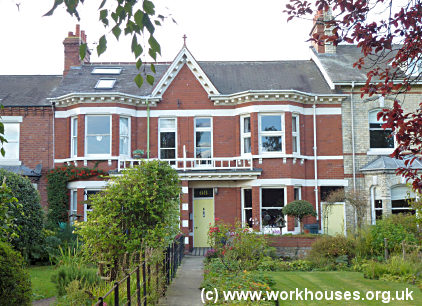
Former scattered home at 68 Wigginton Road, 2012.
© Peter Higginbotham.
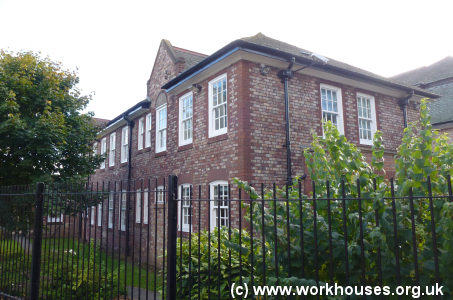
Former central home on Haxby Road, 2012.
© Peter Higginbotham.
Staff
Inmates
Records
Note: many repositories impose a closure period of up to 100 years for records identifying individuals. Before travelling a long distance, always check that the records you want to consult will be available.
- York City Archives, York Explore Centre, Museum Street, York YO1 7DS. Holdings include: Guardians' minutes (1837-1930); Admissions and discharges (1880-82, 1942-58) plus index; Creed registers (1889-1955); Indoor relief register (1907, 1911, 1930); Indoor relief list (1939-41); Births (1886-1945); Deaths (1886-1933, 1942-55); Register of leave of absence to inmates (1930-32); Register of children boarded-out (1898-1920); Vaccination registers (1872-1889, 1899-1907); Register of persons of unsound mind (1936-50); Funerals account (1930-50); Pig account (1930-62); Outdoor Relief application and report books (1837-1929); Register of staff (1912-54); etc.
Bibliography
- Chadwick, A (1996) York Workhouse (Ripon Museum Trust leaflet)
- Kerridge, E (1985) Textile Manufactures in Early Modern England
- Tillott, PM (ed) (1961), A History of the County of York: the City of York (Victoria County History)
Links
- Borthwick Institute's history of St Mary's Hospital and detailed description of archives
- Ripon Workhouse Museum and Garden, Sharow View, Allhallowgate, Ripon HG4 1LE.
Acknowledgement
- Thanks to Penny Lister for passing on the soup story.
Unless otherwise indicated, this page () is copyright Peter Higginbotham. Contents may not be reproduced without permission.


